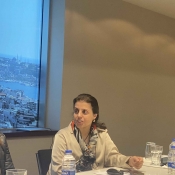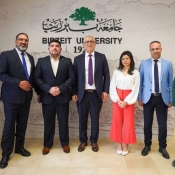Master’s student Mais Majadleh explores new tech to purify industrial water
Mais Majadleh, a master’s student enrolled in Birzeit University’s Applied Chemistry program, published a research paper in Water Resources and Industry, an open-access and internationally renowned journal published by Elsevier in association with the International Water Association.
Majadleh investigated the use of innovative nanoparticle technologies to purify industrial water more efficiently.
The paper is part of Majadleh’s thesis dissertation titled “Application of Fe and Cu Nanoparticles for Methyl Orange Removal from Water and Water-Ethanol Mixtures under Various Experimental Conditions,” supervised by Birzeit University’s chemistry professor Talal Shahwan.
The researcher used cost-effective dye-removal technologies to efficiently extract synthetic and natural dye colorants from water bodies. Majadleh examined the validity of metallic iron nanoparticles and metallic copper nanoparticles interacting in different solvents in the removal of methyl orange dye under various conditions.
Methyl orange is a water soluble chemical contained in the liquid waste of various industries, such as printing, leather, paper and textiles.
The examinations were conducted in three types of solvents: water, water ethanol and water dimethyl sulfoxide. Majadleh found that the removal of methyl orange dye was more efficient in water solutions when using metallic iron nanoparticles, which showed a higher efficiency than metallic copper nanoparticles.
The experimental parameters included solvent type, time, temperature, nanoparticle dosage and salinity, as well as evaluating the material performances as heterogeneous Fenton catalysts.
Majadleh’s research is critical amid constant efforts to respond to the ever-increasing global concern of human-made water pollution—especially through dye-related industries, the leading contamination source of water.
With special contribution from Muntaha Injas, a Birzeit University graduate and researcher at Ulm University, Germany, Majadleh used SEM-EDX, TEM, XPS, and XRD technologies to reveal the structure, morphology and elemental content of both nanomaterials.
Majadleh ultimately found that solute-solvent interactions were more effective than solute-solute interactions; metallic nanoparticles showed more efficiency in clearing dyes such as methyl orange from water.
Full article available here.
Water Resources and Industry ranking: Q1 (2021):
https://www.scimagojr.com/journalsearch.php?q=21100254652&tip=sid&clean=0
Cite Score 9.1 (Scopus)
Impact Factor 4.206







